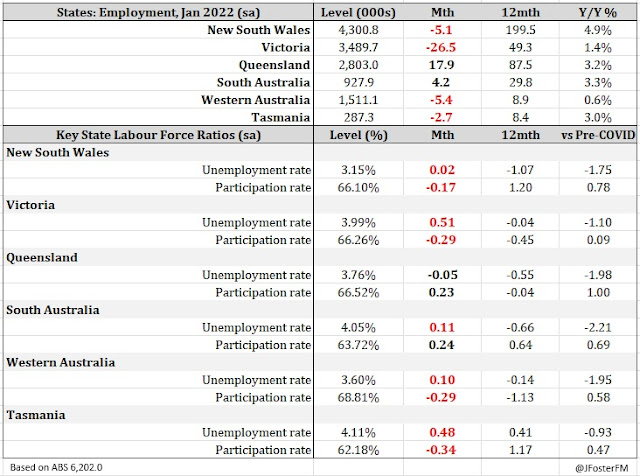Australian labour market activity softened over December and January with today's report for the latter coming in weaker than expected. Obtaining a clean read on labour market conditions is difficult at the moment due to Covid-related disruptions and seasonal factors coming into play over the summer holiday period.
Labour Force Survey — January | By the numbers
- Employment fell by a net 11.5k in January, defying expectations for a 20k rise and the decline in December was downwardly revised to -20k (from -14.6k).
- Unemployment lifted to 3.7% from 3.5%. The underemployment rate remained at 6.1% but the total underutilisation rate lifted 0.2ppt to 9.8%.
- The participation rate declined to 66.5% from 66.6% in December while the employment to population ratio eased from 64.2% to 64%.
- Hours worked fell by 2.1% in the month, mainly reflecting a surge in people taking annual leave in January.
Labour Force Survey — January | The details
Employment fell for the second month running as January's 11.5k decline followed December's 20k fall. This month, the weakness was in full time employment (-43.3k) whereas in December it was the part-time segment (-34.3k) driving the headline fall. Part time employment subsequently rebounded to rise strongly in January (31.8k).
The unemployment rate ticked up to 3.7%, a 0.2ppt increase on the month and up from the October low of 3.4%. Alongside this, the participation rate has eased from 66.7% to 66.5% over the past couple of months. This looks at odds with the rise in the working-age population from the increasing inflow of overseas arrivals and potentially reflects seasonal effects over the December-January period.
Hours worked were down sharply in January (-2.1%), an even more sizeable decline than in December (-1.1%) and the third consecutive fall taking into account November (-0.4%). Over this period, hours worked have slid to be 3.8% above their pre-Covid level in January from a high of almost 8% in October.
In December, a spike in Covid-related absences was largely behind the fall in hours worked. This month, the weakness in hours related to a larger-than-usual rise in workers taking annual leave. The ABS reported that 42.8% of employed Australians worked fewer hours in January due to being on annual leave, the highest share seen for the peak holiday month since 2018. Given many Australians were on holidays, Covid-related absences became a much less acute factor affecting only 2.2% of employed people compared to 5.7% in December.
Labour Force Survey — January | Insights
Today's report was weak across the board in a similar fashion to the December report. In my interpretation, neither of these reports is providing the cleanest read on labour market conditions due to a combination of Covid-related and seasonal factors over the peak holiday period. The ABS reported that more than 5% of people not employed in January were attached to a job, with the majority (3.5%) waiting to start a new job, which will boost the employment numbers in February.
That said, back-to-back weak reports could give the RBA something to think about following its recent hawkish shift. Last week, the Bank forecast the unemployment rate to rise gradually to an average of 3.5% in Q2 and then 3.75% in Q4. That outlook is still attainable given that forward-looking indicators of labour demand remain robust, but it will be a case of watch-and-see with the inflow of overseas arrivals picking up.









